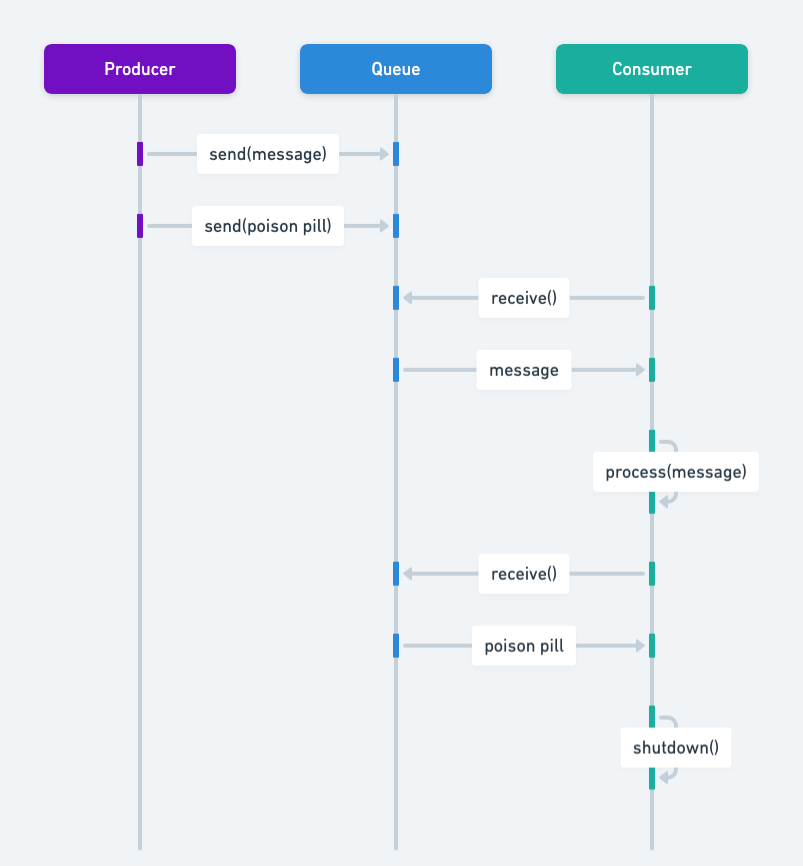Poison Pill Pattern in Java: Gracefully Terminating Multithreaded Processes
Also known as
- Shutdown Signal
Intent of Poison Pill Design Pattern
The Poison Pill design pattern is used to gracefully shut down a service or a producer-consumer system by sending a special message (the "poison pill") to message queue which indicates that no more messages will be sent, allowing the consumers to terminate.
Detailed Explanation of Poison Pill Pattern with Real-World Examples
Real-world example
A real-world analogy for the Poison Pill design pattern is the use of a "closed" sign in a retail store. When the store is ready to close for the day, the manager places a "closed" sign on the door. This sign acts as a signal to any new customers that no more customers will be admitted, but it doesn't immediately force out the customers already inside. The store staff will then attend to the remaining customers, allowing them to complete their purchases before finally locking up and turning off the lights. Similarly, in the Poison Pill pattern, a special "poison pill" message signals consumers to stop accepting new tasks while allowing them to finish processing the current tasks before shutting down gracefully.
In plain words
Poison Pill is a known message structure that ends the message exchange.
Sequence diagram

Programmatic Example of Poison Pill Pattern in Java
In this Java example, the Poison Pill serves as a shutdown signal within message queues, demonstrating effective thread management and consumer communication.
Let's define the message structure first. There's interface Message and implementation SimpleMessage.
public interface Message {
// Other properties and methods...
enum Headers {
DATE, SENDER
}
void addHeader(Headers header, String value);
String getHeader(Headers header);
Map<Headers, String> getHeaders();
void setBody(String body);
String getBody();
}
public class SimpleMessage implements Message {
private final Map<Headers, String> headers = new HashMap<>();
private String body;
@Override
public void addHeader(Headers header, String value) {
headers.put(header, value);
}
@Override
public String getHeader(Headers header) {
return headers.get(header);
}
@Override
public Map<Headers, String> getHeaders() {
return Collections.unmodifiableMap(headers);
}
@Override
public void setBody(String body) {
this.body = body;
}
@Override
public String getBody() {
return body;
}
}To pass messages we are using message queues. Here we define the types related to the message queue: MqPublishPoint, MqSubscribePoint and MessageQueue. SimpleMessageQueue implements all these interfaces.
public interface MqPublishPoint {
void put(Message msg) throws InterruptedException;
}
public interface MqSubscribePoint {
Message take() throws InterruptedException;
}
public interface MessageQueue extends MqPublishPoint, MqSubscribePoint {}
public class SimpleMessageQueue implements MessageQueue {
private final BlockingQueue<Message> queue;
public SimpleMessageQueue(int bound) {
queue = new ArrayBlockingQueue<>(bound);
}
@Override
public void put(Message msg) throws InterruptedException {
queue.put(msg);
}
@Override
public Message take() throws InterruptedException {
return queue.take();
}
}Next, we need message Producer and Consumer. Internally they use the message queues from above. It's important to notice that when Producer stops, it sends out the poison pill to inform Consumer that the messaging has finished.
public class Producer {
// Other properties and methods...
public void send(String body) {
if (isStopped) {
throw new IllegalStateException(String.format(
"Producer %s was stopped and fail to deliver requested message [%s].", body, name));
}
var msg = new SimpleMessage();
msg.addHeader(Headers.DATE, new Date().toString());
msg.addHeader(Headers.SENDER, name);
msg.setBody(body);
try {
queue.put(msg);
} catch (InterruptedException e) {
// allow thread to exit
LOGGER.error("Exception caught.", e);
}
}
public void stop() {
isStopped = true;
try {
queue.put(Message.POISON_PILL);
} catch (InterruptedException e) {
// allow thread to exit
LOGGER.error("Exception caught.", e);
}
}
}
public class Consumer {
// Other properties and methods...
public void consume() {
while (true) {
try {
var msg = queue.take();
if (Message.POISON_PILL.equals(msg)) {
LOGGER.info("Consumer {} receive request to terminate.", name);
break;
}
var sender = msg.getHeader(Headers.SENDER);
var body = msg.getBody();
LOGGER.info("Message [{}] from [{}] received by [{}]", body, sender, name);
} catch (InterruptedException e) {
// allow thread to exit
LOGGER.error("Exception caught.", e);
return;
}
}
}
}Finally, we are ready to present the whole example in action.
public static void main(String[] args) {
var queue = new SimpleMessageQueue(10000);
final var producer = new Producer("PRODUCER_1", queue);
final var consumer = new Consumer("CONSUMER_1", queue);
new Thread(consumer::consume).start();
new Thread(() -> {
producer.send("hand shake");
producer.send("some very important information");
producer.send("bye!");
producer.stop();
}).start();
}Program output:
07:43:01.518 [Thread-0] INFO com.iluwatar.poison.pill.Consumer -- Message [hand shake] from [PRODUCER_1] received by [CONSUMER_1]
07:43:01.520 [Thread-0] INFO com.iluwatar.poison.pill.Consumer -- Message [some very important information] from [PRODUCER_1] received by [CONSUMER_1]
07:43:01.520 [Thread-0] INFO com.iluwatar.poison.pill.Consumer -- Message [bye!] from [PRODUCER_1] received by [CONSUMER_1]
07:43:01.520 [Thread-0] INFO com.iluwatar.poison.pill.Consumer -- Consumer CONSUMER_1 receive request to terminate.When to Use the Poison Pill Pattern in Java
Use the Poison Pill idiom when:
- Systems require robust fault tolerance and seamless consumer shutdown in multithreaded environments.
- In producer-consumer scenarios where consumers need to be informed about the end of message processing.
- To ensure that consumers can finish processing remaining messages before shutting down.
Real-World Applications of Poison Pill Pattern in Java
- Java ExecutorService shutdown using a special task to signal shutdown.
- Messaging systems where a specific message indicates the end of the queue processing.
- Akka framework
Benefits and Trade-offs of Poison Pill Pattern
Benefits:
- Simplifies the shutdown process of consumers.
- Ensures that all pending tasks are completed before termination.
- Decouples the shutdown logic from the main processing logic.
Trade-offs:
- Requires consumers to check for the poison pill, adding some overhead.
- If not managed properly, could lead to consumers not recognizing the poison pill, causing indefinite blocking.
Related Java Design Patterns
- Producer-Consumer: Works in tandem with the Poison Pill pattern to handle the communication and shutdown of consumers.
- Message Queue: Often uses poison pills to signal the end of message processing in the queue.
- Observer: Can be used to notify subscribers about the shutdown event.